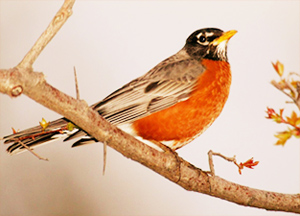The story of For the Birds has two main sources: my strong interest in finding ways to call attention to the animals we live among and the importance of maintaining their habitats, and my friendship with the extraordinary cellist Madeleine Shapiro. In this piece, I wanted to draw attention to the remarkable voices of birds, and to create a conversation between the human voice and the birds. My prior Singing the Blue Ridge (mezzo, baritone, orchestra and electronics made from wild animal sounds) was part of a large project called Preserving the Rural Soundscape, organized by Wintergreen Performing Arts with support from the Americans for the Arts Animating Democracy initiative. I was not interested in creating a litany of complaints about human destruction of habitat, though that would be easy enough to do! I wanted to find ways, through the inclusion of animal voices in conversation with the music, to draw attention to the them and ecosystem in which they thrive. This seems an important step in getting people to preserve habitat. Of course the efforts of the Nature Conservancy and other environmental groups are critical to this process. But making people more aware of the animals around them, through their voices, reaches them in a way that speaks to heart as well as mind.
When Madeleine approached me about composing a piece for her, she had just returned from a trip to Yellowstone, where she loves to hike. Given this connection to that region, I decided to focus on the birds she would have encountered. Madeleine put me in touch with Katy Duffy, the head naturalist for the western end of the park and she also with Kevin Colver, who had made a CD called Birds of Yellowstone and Grand Tetons. He kindly agreed that I might draw on his sources. Meanwhile, I spent hours with Madeleine, trying different types of cello techniques that she knew and developing some others. As an ace interpreter of contemporary music, she demonstrated everything from knocking on the different parts of the cello to finger-flicking pizzicato notes! And when we had her bow her tail piece, the pitch was so close to that of the trumpeter geese, that I knew I would use that in the final movement.
Meanwhile, the problem of form stumped me! So many birds, and the question remained of how to organize them. As I worked on building the soundfiles that I would draw on, I started to think of different ways to shape the piece. I decided to compose four movements, each based on the calls of different types of birds: Songbirds, Sapsuckers, Birds of Prey and Waterbirds. I researched the different birds as well. Yellowstone has an excellent website with lots of information, and I read about many of the individual birds as well. And, as I worked with the soundfiles, I made detailed notes about the types of sounds, the quality of the recordings, and the like. Then I started on the transformations, and spent a great deal of time processing the sounds, using a variety of filters; playing with rhythmic layering, compression, expansion; phase vocoding; microtonal transposition; banded transposition; and much more. It was an intricate, painstaking and at the same time exhilarating, process. Madeleine premiered For the Birds on the annual TechnoSonics festival at the University of Virginia. It became one of the core pieces of her ‘Nature Project,’ and is featured on her Sounds Nature CD. She has performed it widely, on concerts in New York, Miami and London, among many others.

